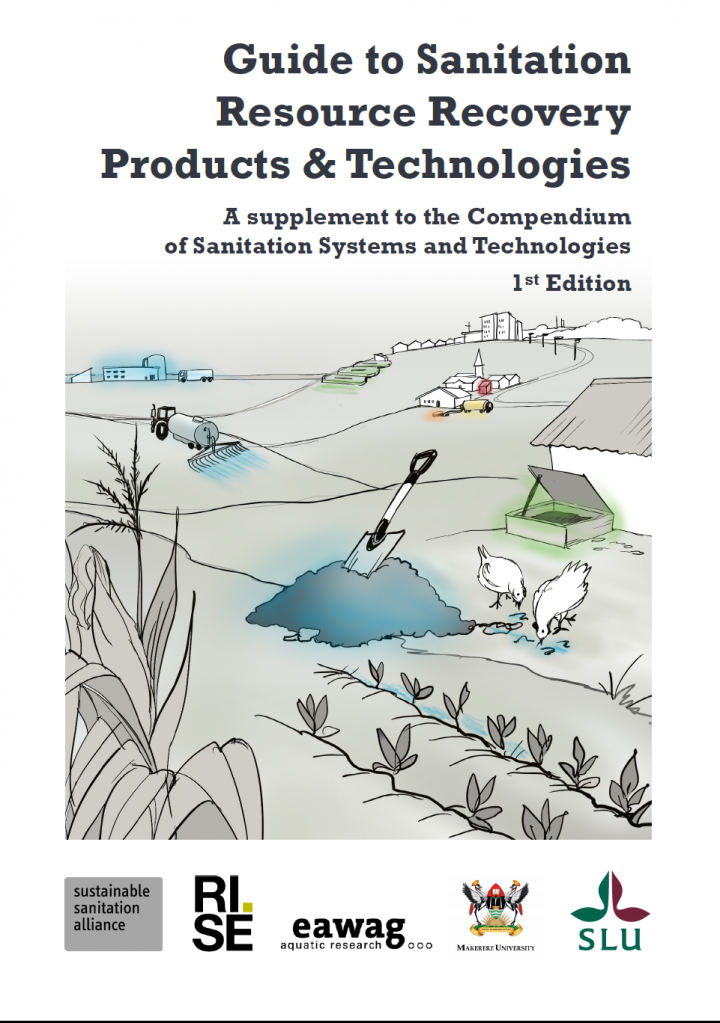Guide to Sanitation Resource Recovery Products & Technologies A supplement to the Compendium of Sanitation Systems and Technologies McConville, J., Niwagaba, C., Nordin, A., Ahlström, M., Namboozo, V. and Kiffe, M. (2020)
The aim of this document is to provide an overview of the possibilities for resource recovery from sanitation and provide guidance on treatment processes to achieve safe products for reuse. The focus of this document is on resource recovery from the organic wastes managed in sanitation systems and, to a lesser extent, on the recovery of water and energy generation. Resource recovery sanitation systems are defined as systems that safely recycle excreta and organic waste while minimising the use of non-renewable resources such as water and chemicals. Safe recycling means that waste flows are managed so that physical, microbial and chemical risks are minimised. Thus, the recycled product should not pose any significant health threat or environmental impact when correctly used.
The specific objectives of this document are:
1. To expose the user to a broad range of recovered sanitation products and innovative treatment technologies.
2. To help the user to design functional solutions for resource recovery by illustrating the linkages between sanitation inputs, treatment technology and the recoverable products.
3. To provide an overview of basic information regarding design aspects, operational requirements and health, safety and social considerations related to resource recovery technologies and products.
4. Describe and fairly present technology-specific advantages and disadvantages.
External Website(s)
Compendium of Sanitation Systems and Technologies - (2nd Revised Edition)
Launching Webinar of the Guide to Sanitation Resource Recovery Products & Technologies
Bibliographic information
McConville, J., Niwagaba, C., Nordin, A., Ahlström, M., Namboozo, V. and Kiffe, M. (2020). Guide to Sanitation Resource Recovery Products & Technologies A supplement to the Compendium of Sanitation Systems and Technologies Swedish University of Agricultural Sciences (SLU). Uppsala, Sweden
Filter / Tags
Food security and productive sanitation (WG5)Biogas systems Composting, vermicomposting (solid waste), composting toiletsFaecal sludge treatment processesFundamental research and engineeringVermifilters, vermifilter toiletsFaeces or faecal sludgeGreywater or wastewaterUrinePoliticians and local decision makersPractitionersEnglish
External links
Compendium of Sanitation Systems and Technologies - (2nd Revised Edition)
Launching Webinar of the Guide to Sanitation Resource Recovery Products & Technologies
Downloads
Guide to Sanitation Resource Recovery Products & Technologies
Type: application/pdf
Size: 15.61 MB

Published in: 2020
Pages: 148
Publisher:
Swedish University of Agricultural Sciences (SLU). Uppsala, Sweden
Author(s):
McConville, J., Niwagaba, C., Nordin, A., Ahlström, M., Namboozo, V. and Kiffe, M.
Uploaded by:
SLU
Swedish University of Agricultural Sciences
